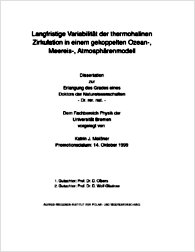Langfristige Variabilität der thermohalinen Zirkulation in einem gekoppelten Ozean-, Meereis-, Atmosphärenmodell
Meißner, Katrin J.
Univ. Bremen
Monografie
Verlagsversion
Deutsch
Meißner, Katrin J., 1999: Langfristige Variabilität der thermohalinen Zirkulation in einem gekoppelten Ozean-, Meereis-, Atmosphärenmodell. Univ. Bremen, 132 S., DOI: 10.23689/fidgeo-477.
 |
Dokument öffnen: |
Thermohaline circulation, variability, energy and moisture balance model, paleoceanography. - Freshening of high latitude surface water can change the large scale oceanic transport of heat and salt. Consequently, atmospheric and sea ice perturbations over the deep water production sites excite a large scale response establishing an oceanic t̀̀eleconnection'' with time scales of years to centuries. To study these feed-backs, an atmospheric energy and moisture balance model (EMBM), predicting the heat and fresh water fluxes at the surface, and a thermodynamic sea ice model were constructed and coupled to the GFDL ocean model MOM2. The heat and moisture transports by transient eddies in the EMBM are parameterized by diffusion. The coupled model reproduces many aspects of today's oceanic circulation. The most interesting features of the coupled model are the sensitivity of the thermohaline circulation to changes in the configuration, the multidecadal variability in the ocean-sea ice system, and the behaviour of the thermohaline circulation during transitions between glacial and interglacial periods. A very strong thermohaline circulation develops in the coupled system that is not evident in the stand-alone ocean model. An interesting aspect of this behaviour is the existence of a maximum strength in the overturning. Beyond this maximum, evaporation in the subtropics cannot balance the northward salt-transport. As a result, the watermasses over the deep water production sites become fresher, leading to a collapse of the thermohaline circulation. The associated changes in the sea ice cover prevent the system to recover. ...

